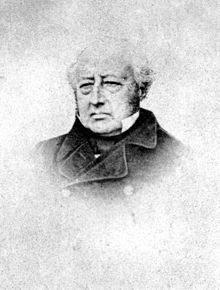Edward Bury
| Edward Bury | |
|---|---|

by Unknown 1850s
|
|
| Born |
22 October 1794 Salford, Lancashire |
| Died | 25 November 1858 (aged 64) Scarborough |
| Nationality | British |
| Engineering career | |
| Institutions |
Royal Society (1844) Royal Astronomical Society Royal Historical Society Smeatonian Society of Civil Engineers Institution of Civil Engineers |
Edward Bury (22 October 1794 – 25 November 1858) was an English locomotive manufacturer. Born in Salford, Lancashire, he was the son of a timber merchant and was educated at Chester.
By 1823 he was a partner in Gregson and Bury's steam sawmill at Toxteth Park, Liverpool, but in 1826 he set himself up as an iron-founder and engineer. His original premises were in Tabley Street near the Liverpool and Manchester Railway's workshops. He hoped to supply locomotives to that line, but opposition from the L&M Engineer, George Stephenson, thwarted this.
He moved his works to new premises in Love Lane, Liverpool, on the Leeds and Liverpool Canal and near the Clarence Dock, hence the name 'Clarence Foundry and Steam Engine Works'. Around this time he recruited as his manager James Kennedy, who had gained locomotive building experience working for George Stephenson and Mather, Dixon and Company. The first locomotive built by Edward Bury and Company, Dreadnought, was intended to compete in the Rainhill Trials, but could not be finished in time. It was a 0-6-0 and did some ballasting work on the L&MR but is said to have been objected to because it was on six wheels. It was sold to the Bolton and Leigh Railway in 1831.
Bury's second locomotive Liverpool was on four wheels, and was tried on the Liverpool & Manchester but the objection this time was to the size of the wheels, 6 feet in diameter, described as "dangerous" by George Stephenson. The wheels were reduced to 4 feet 6 inches, but this engine also went to the Bolton & Leigh. Thereafter, Bury only succeeded in selling one engine, Liver, to the Liverpool & Manchester Railway.
...
Wikipedia
